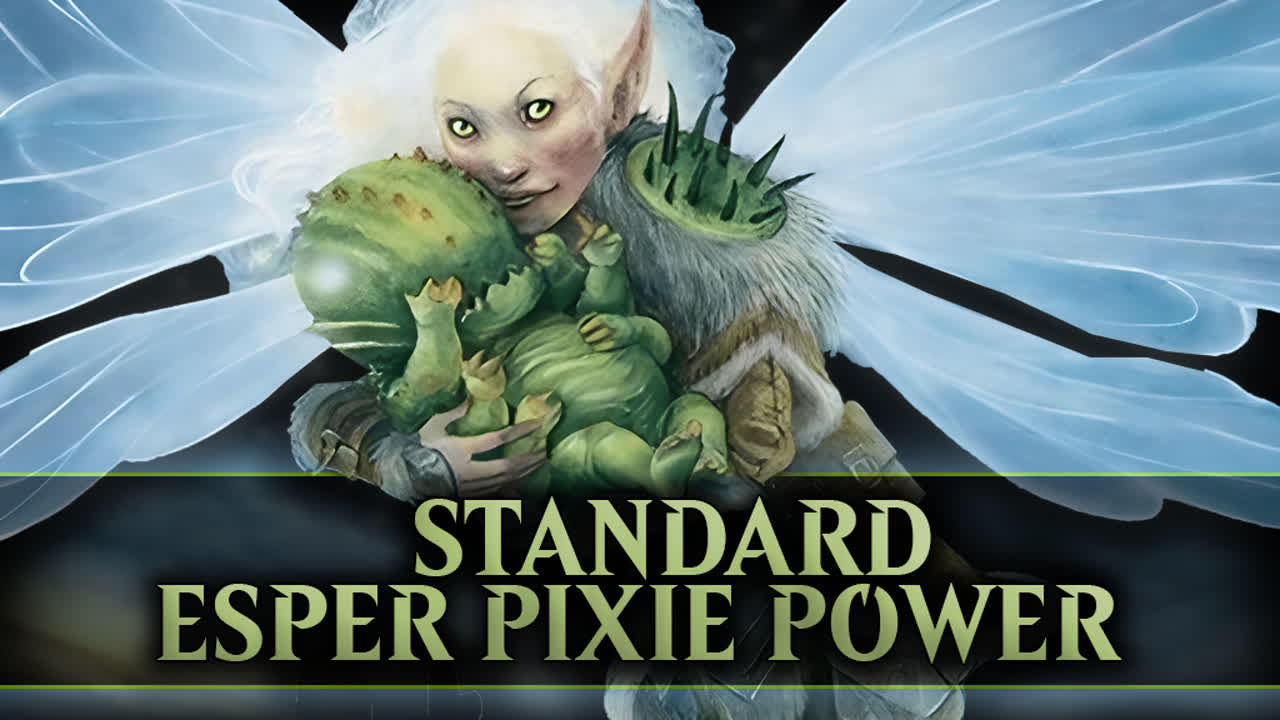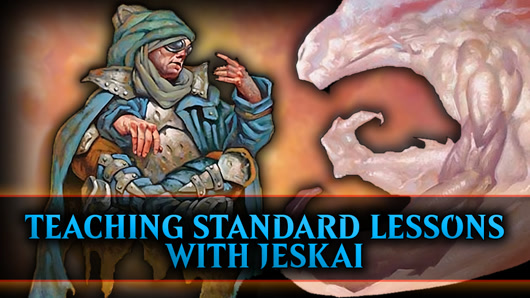Welcome Magic lovers! Happy New Year!
As the rest of the world ushers in the coming year, competitive Magic: the Gathering players are still stuck in late 2024…at least until the end of the ongoing Standard Regional Championship Qualifier season, which won't wrap up until a couple of months from now.
The format up to this point has seen several big shifts as players try to get an edge over one another in their attempts to find the best deck for any given weekend, and uncover any hidden gems that may be lurking in the new sets that have been released since the qualifier season began.
The last several weeks have seen Dimir Midrange rise in popularity to become the most-played deck, making up about 20% of the Standard meta game, alongside several low-to-the-ground, aggressive decks like Mono-red, Gruul and Boros. With Jeskai Convoke making a return to tier 1 in order to beat Dimir and Golgari, as well as the more recent Simic Crab lists that began popping up in the top 8's of various tournaments, it seemed like the format had coalesced around one and two-mana spells and the decks that leverage them in the most powerful manner.
That is until, in the last couple of weeks, Standard players discovered that there was yet another, powerful way to attack the format with cheap spells: Esper Pixie, a.k.a. Esper Bounce.
The Plan
Featuring a suite of relatively low-power creatures and spells that cost only one or two mana, this Esper deck aims to exploit the synergy between them in order to do something greater than the sum of its parts. The extremely low cost of its spells and creatures means its almost always trading up on mana for any removal spells or interaction opponent's may have. It definitely doesn't feel good for the opponent when they're casting Get Lost to try and remove a single-mana enchantment that already generated value, or a Go for the Throat on a one-drop that's now a 4/4 flyer which must be dealt with.
The key pieces are actually its non-creature enchantments, Hopeless Nightmare and Stormchaser's Talent, which are capable of generating a ton of value and card advantage as they are bounced back to hand and replayed over and over again. As we saw in the Temur Otters deck that debuted at the Magic World Championships several months ago, Stormchaser's Talent can do some very impressive things, like looping infinitely when combined with the right bounce effects, and Hopeless Nightmare not only attacks the opponent's resources in hand, but is also capable of quickly draining the opponent of their last few life points.
Speaking of bounce effects, Nurturing Pixie and Fear of Isolation, backed up by This Town Ain't Big Enough do most of the heavy lifting, quite literally, as they allow the pilot to pick up the deck's two, crucial enchantments, along with anything else that may generate value when it enters the battlefield. This includes efficient removal spells like Nowhere to Run and Sheltered by Ghosts, or even a creature that triggers upon entering the battlefield, like Spyglass Siren.
The fact that both Nurturing Pixie and Fear of Isolation, as well as Spyglass Siren, all have flying is quite relevant, as they make perfect targets for the +1/+1 counters from Optimistic Scavenger, which is another important piece of the deck's plan as it allows the pilot to rapidly pump its smaller, easily-outclassed creatures into formidable, evasive threats.
Interaction for the opponent's permanents is typically taken care of the pair of new enchantments, Nowhere to Run and Sheltered by Ghosts. Nowhere to Run has been steadily ticking up in popularity as it allows one to circumvent paying the annoying ward costs from cards like Sheltered by Ghosts and Innkeeper's Talent, to ignoring hexproof and shrinking a Kaito, Bane of Nightmares when it attacks, to the point where it can be blocked and eaten by even a small creature.
Sheltered by Ghosts has already proven how powerful it can be in the Jeskai and Boros Convoke decks, but in Esper Pixie, it can not only take care of a problematic permanent early, but can be bounced and replayed several turns later in order to take care of a more serious threat down the line. Sheltered by Ghosts can often come down early in the game and eat a creature, map or clue token to cut into the opponent's resources, then be returned to hand and used again later without giving them anything back when it leaves the battlefield. Backed up by one or two Go for the Throat and Cut Down, this removal suite in the deck can easily handle any early-game creature or non-creature threats the opponent may present.
However, of all the cards mentioned thus far, the most powerful one in the deck may actually be This Town Ain't Big Enough. Everyone saw how potent it was in the Temur Otters and, later, the Simic Crabs decks that leveraged it alongside Up the Beanstalk and Stormchaser's Talent in order to create a loop to draw one's deck while also generating a tempo advantage. In Esper Pixie it is an incredible enabler for the synergy that this deck is trying to create, bouncing not one, but two permanents simultaneously for only two mana at instant speed. This allows the pilot to either play it aggressively, returning Hopeless Nightmare, Stormchaser's Talent or even a couple of opposing blockers in order to attack the opponent's hand or life total, or defensively, as a way to remove a couple of problematic permanents and create some breathing room for a turn or two. Bringing it back with Stormchaser's Talent to keep bouncing things for value while pumping out 1/1 otter creatures is also a fantastic way of continuing to keep the gas flowing, allowing the deck to never really run out of steam.
Entity Tracker is the final card of note to mention here, allowing the deck to generate a ton of card advantage and quickly run away with the game if it survives. Drawing multiple cards a turn with an Entity Tracker in play is a trivial matter, and even if the opponent does have a removal spell for it, the Tracker's ability to come into play on the end step of a turn when they're tapped out means it will almost always replace itself at the very least before they can untap and kill it.
The Lands
Ah, and finally we come to the one weakness of the deck: its manabase.
Playing a low-curve deck generally entails running between twenty to twenty-three lands, in order to maximize its spell density and ensure that its pilot finds enough action to end the game before an opponent’s more expensive, powerful spells can take over.
Playing three colors in a low-curve deck, however, comes at a serious cost to the mana in order to ensure there are enough colored sources in the deck to cast its spells on time. You won’t find more than one or two basic lands in these lists for that reason, and while its possible to get away with playing twenty-three dual lands, it comes at a serious cost to one’s life-total (we all know why they’re called ‘painlands’).
Trying to play any combination of blue, black and white one-mana spells on turn one and two can be a real headache in some games, and requires careful consideration of which hands to mulligan or keep. This is almost certainly a big reason why more recent lists have gradually moved away from cards like Spiteful Hexmage or Kaito, Bane of Nightmares in the main deck.
Fortunately, cards like Demolition Field are seeing almost zero competitive Standard play at the moment, though there has been an uptick of Mono-white Control decks playing two or three copies.
The Sideboard
Anything with an excellent enter-the-battlefield trigger could potentially be a contender for the sideboard of this deck, with cards like Loran of the Third Path (backed up by Destroy Evil), being a great way to deal with artifacts and enchantments, while Tithing Blade is a reusable way to eat large creatures or those with hexproof and ward.
Sun-Blessed Healer is a new addition that can really give the deck a lot of additional late-game grind, allowing the pilot to win any war of attrition against a removal-heavy opponent.
After that, there are silver bullets like Rest in Peace to tackle graveyard decks like Azorius Oculus and Simic Crabs, while Pest Control, and to a lesser extent, Split Up, are fantastic cards against Jeskai Convoke and the Esper Pixie mirror match.
Kaito, Bane of Nightmares comes in against controlling decks like Mono-white Caretaker's Talent and Domain Zur.
Other honorable mentions include Defiled Crypt // Cadaver Lab, which gives the deck a great way to grind in the late game. Against aggressive red decks, The Witch's Vanity doubles as not only another removal spell that can be bounced and replayed over and over again but it also generates food each time to keep one's life total at a safe level.
Conclusion
Esper Pixie is the real deal, as its low-curve and high synergy make it powerful yet simultaneously difficult to profitably attack. It is aggressive enough to get under the late-game decks, while being fast enough to stonewall opposing aggro strategies. It is capable of generating card advantage and board presence more quickly than many of the other top decks in Standard, and its ability to grind in the mid-late game means its no simple matter to go over the top of it.
Simultaneously attacking both the opponent’s cards-in-hand and life total makes it difficult for them to effectively fight back on both axes, putting the opposing player into an increasingly precarious position.
However, there are weak spots. The deck's mana base, as mentioned previously, is far from ideal, and if Demolition Field starts becoming popular it poses a problem. Cheap sweepers like Pest Control and Temporary Lockdown are anathema to this deck, and can easily sweep away their entire gameplan all at once. Esper Pixie benefits from the fact that the printing of Authority of the Consuls has caused white decks to cut their sideboard Temporary Lockdowns in favor of the new, life-gaining enchantment against the aggressive decks, though that may soon change again.
Overall, Esper Pixie should definitely be a top choice for anyone looking to participate in a Standard tournament coming up, though with its many varied and intricate lines of play and tricky mana, the deck rewards experience and a practiced hand, so get as many reps in as possible before registering it!
































